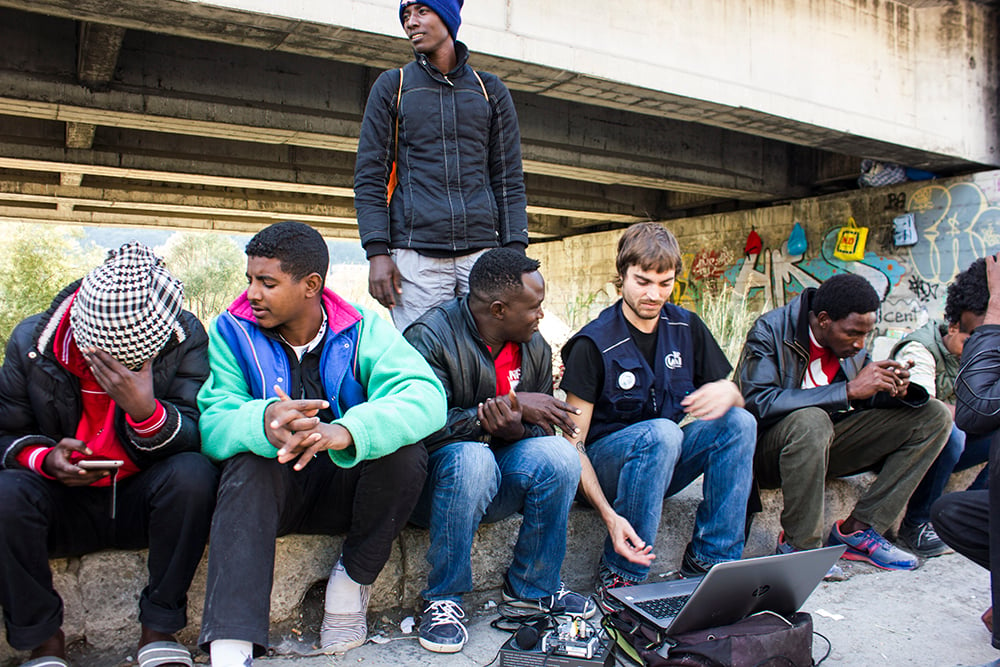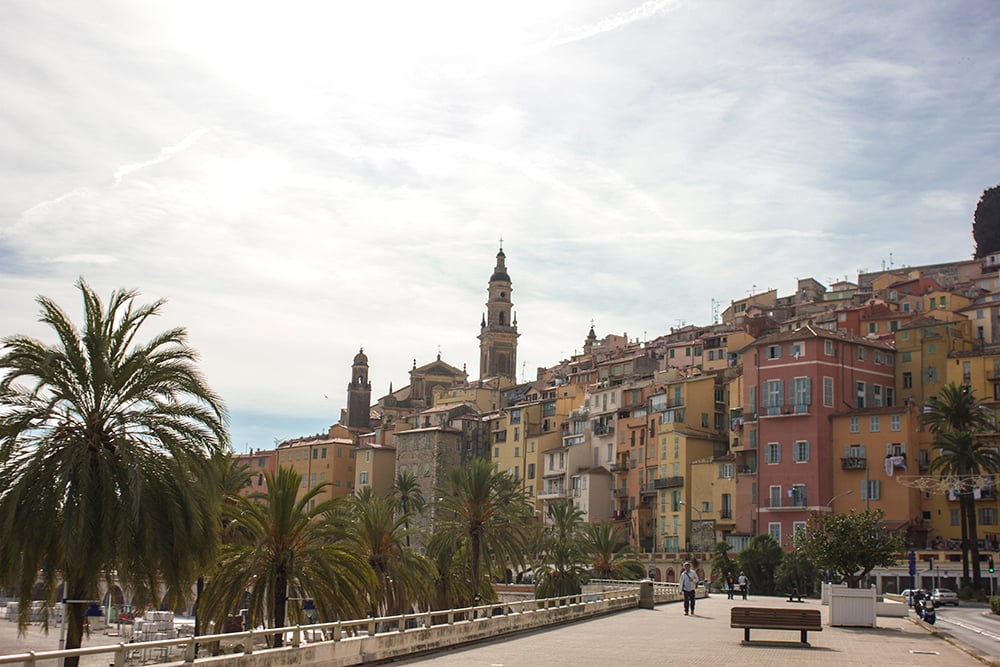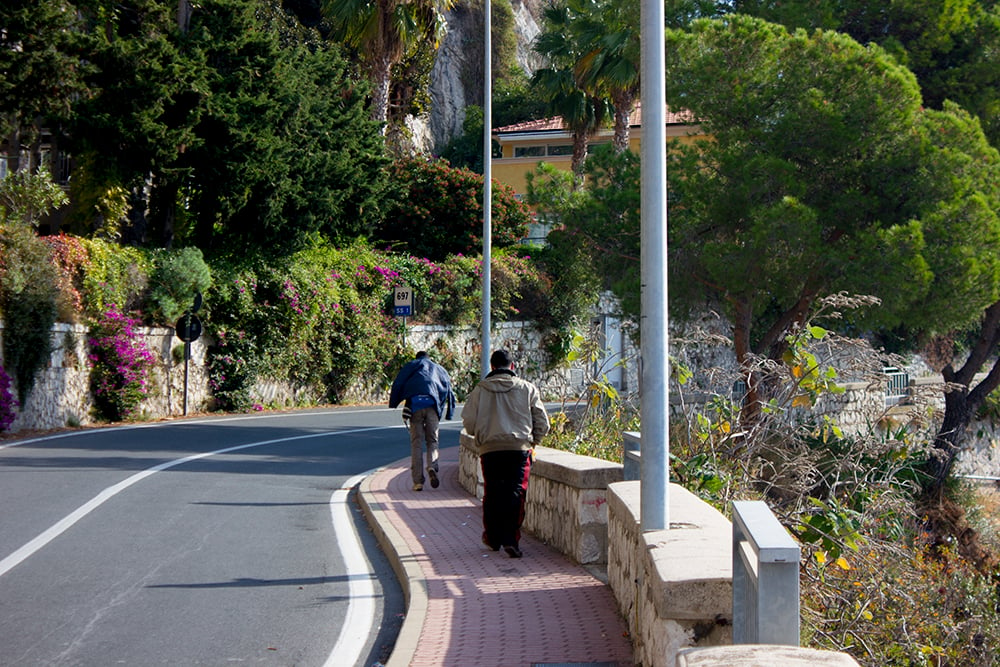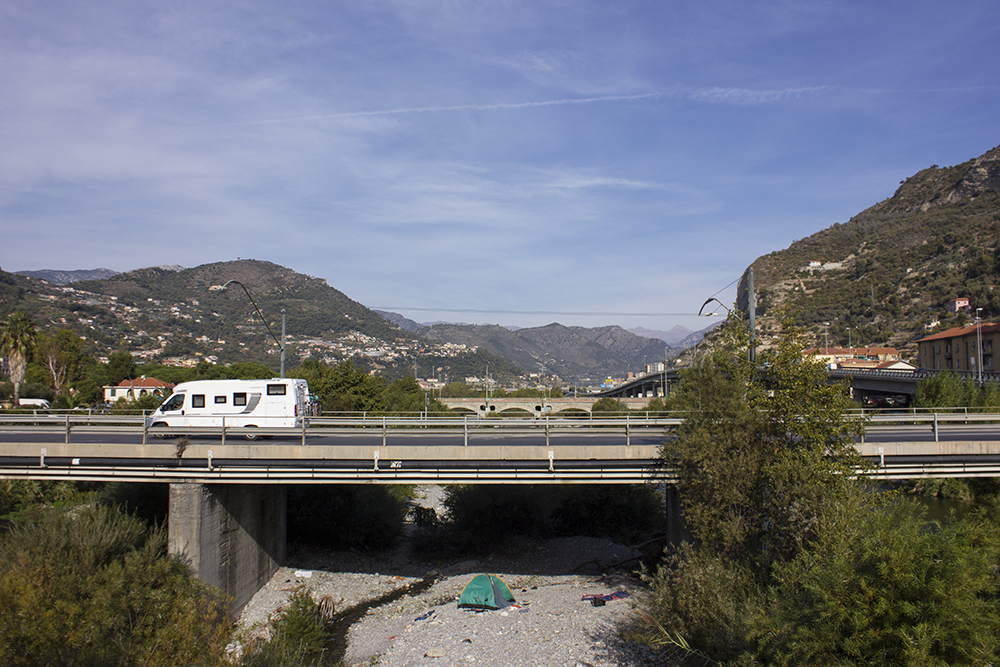Ventimiglia is idyllic. It sits just across the Italian border from the French Riviera. The piercingly blue waters of the Mediterranean churn against its rocky beaches, and its buildings, painted in earthy pastels, back up against the foothills of the Alps. On Fridays, the normally quiet streets are bustling with French tourists who cross the border by car, train, and bicycle to shop in its famous markets where artisans and farmers sell clothes, leather items, fresh produce, truffles, cheeses and decadent pastries. Families with young children and elderly couples stroll along the streets and sit at sidewalk cafes or eat in one of the many restaurants along the shore.
But just a short walk from the town centre, another set of visitors inhabits what seems like an entirely different world. These people are mostly from sub-Saharan Africa and have crossed the Mediterranean Sea in search of safety, economic opportunity, or both. For them, Ventimiglia is a bottleneck – one of many points where people get stuck along the long and brutal migration trail stretching from east and west Africa into northern Europe.
Their Ventimiglia consists of rows of blanket-laden mattresses under a bridge; a crowded, volunteer-run information point where they can charge their phones and use the internet; a secluded riverbank where they wash their clothes; long lines at a local charity where they wait in turn to shower and receive their morning meal; and a parking lot where they whittle away time playing football, sitting, watching, and waiting to try to cross the border to France.
This Ventimiglia is a purgatory. On the dividing line between two of the founding member states of the EU, it is a distillation of the neglect and trauma asylum seekers experience at each step of the desperate journey towards Europe, and a place where their dreams of a better life begin to crumble.

Forced to cross illegally
Home to 24,000 people, Ventimiglia is just five miles (eight kilometres) from the French-Italian border. Its railway station is the last stop in Italy before the tracks crossover into France. The economy is reliant on the free movement of people and goods across the border, a benefit of the Schengen Agreement, which abolished passport controls within the EU. But in June 2015, as an unprecedented number of asylum seekers were crossing the Mediterranean for the second year in a row, France reintroduced border checks in an attempt to stop refugees and migrants from entering its territory.
Ventimiglia was already one of the major transit points for thousands of people who landed in Italy but who wanted to move on to northern European countries with better social services and stronger economies. At the time, Italy was not fully enforcing the Dublin Regulation, which requires asylum seekers to apply for protection in the first EU country they enter, and there was already a growing wave of Islamophobia and anti-migrant sentiment across the continent that was prompting governments to try to keep the crisis at bay.
The reinstated border controls did not prevent asylum seekers from crossing into France; they only made it more difficult. Instead of simply taking the train across the border, asylum seekers are now forced to pay smugglers, or to take riskier routes along railroad tracks or dark and winding roads at night or even over dangerous mountain passes that take two or three days to cross. Since September last year, at least eight people have died attempting these routes. “That people should be dying to cross from Italy to France in 2017; that’s just disgraceful,” said Judith Sunderland, Human Rights Watch’s associate director for Europe and Central Asia.
Even when asylum seekers do make it across, a 1997 agreement between Italy and France allows French police to push them back if they are found within certain areas close to the border. As a result, people often have to try multiple times before they can cross successfully. Those who are sent back end up staying in Ventimiglia until they try again.
At any given time, there are between 300 and 900 asylum seekers in the small town. The majority of people when I visited at the end of October were from Sudan, and there were also people from Chad, Eritrea, and other sub-Saharan countries. A recent spike in arrivals to Italy from Tunisia and Algeria also led to an increase in the numbers of North Africans trying to cross the border to France. Most people stay at a camp set up by the Red Cross a several-mile walk outside town or sleep rough under a bridge closer to the few services that exist in the town centre.
On a warm afternoon in late October, a young man carrying two backpacks wandered into the parking lot next to the bridge. Wearing a heavy coat and a winter hat emblazoned with a British flag, he put his bags down, unzipped his jacket and, without missing a beat, raised his hand to join the football game being played on the asphalt in front of him. A murmur went around that he must have tried to cross the border earlier that day and had been sent back.
The two-hour walk from the border back to the parking lot was well known by many of the people gathered there. Regardless of how asylum seekers try to cross, if they are caught in French territory they are taken to a police station on a road overlooking the coast and then sent walking up the hill, across the border, to the Italian police station on the other side. The Italians register their arrival and sometimes put people on buses that take them to Taranto, 750 miles away in the heel of Italy’s boot. If they aren’t sent to the south, the police let people go and they continue the walk back to Ventimiglia.
But the difficulties often start well before the border.
Train checks
The most obvious way to get to France from Ventimiglia is by train, and most asylum seekers try their luck this way at least once, even though the odds of making it are long. Late one Sunday morning, I boarded the train at the station in Ventimiglia and found Hussein, 16, and Jawahir, 18, sitting in one of the cars. Both of them were from Sudan and had arrived in Italy recently from Libya, where they had faced torture and abuse. “[The smugglers] took plastic bags, held a lighter to them and let them drip on my foot while they made me talk on the phone to my family,” Jawahir was saying. But his story was interrupted when Italian police officers boarded the train and began checking the carriages and bathrooms. Hussein and Jawahir scrambled from the train and had already disappeared from sight by the time I followed them out onto the platform.

I boarded the train again and it rolled out of the station, gliding past the shimmering waters of the Mediterranean and then plunging into dark tunnels as it headed along the jagged coastline towards the border. There were a couple dozen tourists scattered throughout the cars, and the ride lasted no longer than 20 minutes before we pulled into Menton-Garavan station, the first stop in France.
When the train doors opened, a handful of French police boarded wearing black rubber gloves and did a sweep of the cars while several officers stood by outside making sure no one snuck off before the sweep was complete. When I exited, one man from North Africa, who had evidently evaded the police on the Italian side, was standing against the wall of the station pleading with the officers in French. Two police vans idled in the parking lot waiting to take whoever was caught that day back to the border.
Special rules for children
Outside the station, holidaymakers strolled leisurely along the corniche and through a pop-up market next to the sea. The sun was out, and some people were lounging on the beach and splashing in the water even though it was the end of October. In the centre of town, the restaurants were full of people enjoying platters of seafood for their Sunday lunch, and there was a man playing Spanish guitar in the middle of a historic square with a woman dancing along beside him.
There was no hint of the asylum seekers camped out under the bridge six miles away, trying with stubborn tenacity to reach this place – until I returned to the train station. The afternoon sun had slid behind hazy clouds, and the breeze now carried an autumnal chill. About 10 minutes before the train back to Italy was due to arrive, French police brought a group of asylum seekers to the platform. There was a family with three young children – two of them barely toddlers – and a young man who sat against a wall as police officers hovered nearby.
Families, women, and unaccompanied minors are often sent back on the train instead of being taken to the border. The pushback of unaccompanied minors is particularly problematic. According to the Dublin Regulation, they are supposed to be afforded a 24-hour waiting period before being returned. During this time, authorities are obligated to establish if the minor has family connections in the country where they were found, which would take precedence over sending them back to the country where they first arrived. The European Court of Justice also ruled that, unlike adults, children should not be required to apply for asylum in the country they first entered the EU. So, pushing them back across the border without informing them of their rights, trying to establish if they have family members in the country, and giving them the opportunity to apply for asylum is against France’s legal obligations.
Unaccompanied minors make up a big percentage of the people who are trying to cross the border and who are being sent back. In 2016, the charity Caritas, which runs a shelter in Ventimiglia for children and other particularly vulnerable people, hosted 3,000 unaccompanied minors. And those are just the ones who were counted. Alessandro Verona, a doctor working with the Italian NGO INTERSOS, estimates that up to 35 percent of the people sleeping under the bridge in Ventimiglia are also children and, since many of them never enter the shelter, they are uncounted in the statistics. “The ‘French Dream’ or the ‘English Dream’ is very strong on these youngsters,” Verona said.
The young man being sent back from the station in Menton was from Sudan. His name was Hamed, and he was 15 years old. The officers escorted him on board the train and stood guard outside the doors waiting for it to leave. Later, he showed me the refusal of entry form he was given by the French police. Most of the sections were not filled out, but it clearly stated his date of birth as 1 January, 2002.

Hamed had been in Italy for less than a month and arrived in Ventimiglia only four days before. He had already tried to cross the mountains into France, but was sent back that time as well. When the train reached Ventimiglia, he walked onto the platform and out of the station like any other passenger and made his way back to the bridge.
Why not stay in Italy?
On a cold night, I sat in the parking lot next to the bridge speaking with Adam, a 30-year-old asylum seeker from Sudan. The football matches had ended after the sun went down, and now around 300 other people were in the parking lot waiting for volunteers to arrive and serve dinner. Adam was tall and had a warm smile and a scarf wrapped tightly around his neck. He had been sleeping under the bridge for close to two weeks and had already tried to cross the border three times.
“The first time we tried, we went by train and were sent back,” Adam said. “Another time we tried in the mountain pass. We saw so much danger and so many difficulties. We saw death. We walked in the mountains for two days before we arrived to an area on the French border. We arrived and they sent us back again. Three days in the mountains. On the third day they sent us back.”
Another time, he tried walking along a road. After eight hours, the police caught him and sent him back. Now, he had paid a smuggler and was waiting to try to pass again. “We’re still sleeping under the bridge in the cold,” Adam said. “There’s no safe place. It’s difficult. There’s food and other things, but it’s not enough. Hopefully, it will only be for a period of time and then it will be over.”
I asked him why he didn’t want to stay in Italy. “We heard from people who came here before us that they had housing for a period of time and then they were kicked out,” he said. “That’s a problem. There’s no housing and not much money.”
Adam wanted to go to England “because of the language”, he said, switching from Arabic into English and flashing his smile. “I have little English.” His wife and five children were in Saudi Arabia, where Adam had worked as a migrant labourer. He left and came to Europe because his family did not have documents in Saudi Arabia, which made it difficult for his children to get an education or access resources like medical care. And going back to Sudan wasn’t an option because he was worried about conflict and instability. He wanted to bring his family to Europe so they could be somewhere safe and stable, and where his children could get an education. “You want to live like a human,” he said.
His stay in Ventimiglia had been frustrating and demoralising, but he was still determined. Every time I left the parking lot at night Adam would say: “I hope you don’t find me here tomorrow.” It seemed to him like the French were making people suffer unnecessarily by making it difficult to cross the border. “They know that anyone who is trying to enter France, we will try and try, again and again. Why put these difficulties and make the way risky?” he asked. “We know that we will enter. There’s no other solution. Why put these punishments?”
Life in limbo
A recent report by the Refugee Data Project documented a lack of access to sanitation, clean drinking water, food and medical care for asylum seekers in Ventimiglia. Out of 150 people surveyed, 42 percent knew someone who had died trying to cross the border, and over 40 percent said they had experienced violence from both French and Italian police, including verbal abuse, physical assault, and being tear-gassed. Sixty-one percent of people said that they had been taken by Italian police and deposited in Taranto. “There are some guys who went to Taranto four or five times. It is something that destroys you physically and mentally,” a volunteer named Sara, who asked me not to use her last name out of fear of police harassment, told me.

For the time that people are stranded here, life takes on a soul-crushing routine. They arrive after their long journeys and find a place to sleep in the Red Cross camp or under the bridge. They wait in line for food and toilets or simply go to the bathroom by the river. They wait in line to charge their phones and use the internet; wait in line to pick up warm clothing to guard against the cold at night. They sit by the parking lot watching the afternoon football matches until the sun goes down, and then they wake up the next morning and do it all over again. The municipality and local residents are hostile to their presence because they are afraid the asylum seekers will scare away the tourists that the town’s economy is dependent on. And then there are the attempts to cross the border, and being sent back over and over again. And all of this after people have already been through so much to make it this far.
The endless journey
On my last afternoon in Ventimiglia, I bumped into Hashem, a 22-year-old Sudanese asylum seeker I’d met a couple of weeks earlier in Rome. He was walking towards the sea with a friend and asked if I wanted to come along. As we meandered towards the rocky beach, he said he didn’t know the streets – he had only arrived the night before, and Ventimiglia was foreign to him. He came to Europe because he wanted a better life. “I was a refugee in my own country. The village where I was born in Darfur was burned to the ground,” he said. The people he grew up with are scattered. Some are in other countries in Africa and others made it to Europe, Canada, and the United States. “I wanted to do what you do,” Hashem told me, asking what he should study to become a journalist. He hadn’t graduated from high school in Sudan, but picked up newspapers and read whenever he could.
“The things I experienced in Libya were very hard,” he said. His disappointment with Europe was evident. “After what we experienced, we deserve better than this.” But on some level he understood. So many people like him had come before and it’s hard for European countries to house them all, support them financially, and help them find work. But what other choice did he have? “The future I want is impossible in Africa,” he said. “Good schools are only for the wealthy and there is no freedom.”
We knelt on the rocky beach for a minute listening to the soothing rush as the waves crashed and then pulled back out to sea. The sun was starting to set in the western horizon, turning the jagged coast of France, only five miles away, into a hazy silhouette. Hashem’s plan was to try to cross to France and then Germany and apply for asylum. He wanted to pretend to be a minor. That way, he hoped he wouldn’t have an issue with the Dublin Regulation. “I’m so skinny because of what I’ve been through. People will think I’m younger,” he said with a sad laugh.
He asked me about whether it would be possible for him to finish his studies and go to university. He was smart and determined, but also tired and obviously scarred by his experiences. He had plans for his future. But what he’d been through already was so difficult. Would he be able to continue on – especially now that he felt so unwanted, unwelcome, and unsupported where he was?
I thought about a conversation I’d had the night before with Alessandro, the doctor from INTERSOS. He had described the journey from people’s home countries to Italy as a rush. “Your shadows will not catch you,” he said of the traumas people are escaping and experience along the way. But when they get stuck in Ventimiglia, that changes. “You stop yourself under a place that is full of these shadows – full of these nightmares – with all these people with the same problem, and you stop because you don’t know what to do anymore… All of the thoughts are coming back, and then you lose your strength. The resilience is gone.”
When people finally cross into France, it is still not over. There are more borders that are closed and more bridges in other cities where asylum seekers sleep rough at night. And then, when someone finally reaches their destination and applies for asylum, “most of the time… Dublin will make them come back,” Alessandro said. “You find yourself back in Gorizia, back in Bolzano, back in Ventimiglia, back in Torino,” he added, repeating the names of places along the migration trail through Italy. Even once they’ve arrived, the long and brutal journey doesn’t end.
er/ag





